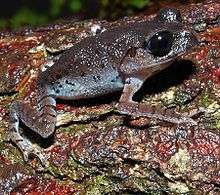Leptobrachium hasseltii
Leptobrachium hasseltii (Hasselt's toad, Java spadefoot toad, Hasselt's litter frog, Tschudi's frog) is a species of toad found in Southeast Asia. This frog named after Dutch Naturalist Johan Conrad van Hasselt.[2] According to the current understanding, this species is known with certainty only from Java (also the type locality), Madura, Bali, and Kangean Islands, Indonesia.[3] The species is also commonly reported to occur in the Philippines (Palawan, Mindoro, Bohol, Basilan, Mindanao islands),[4] but these are believed to refer to another, unnamed species.[1][3]
| Leptobrachium hasseltii | |
|---|---|
 | |
| Male Leptobrachium hasseltii from Bogor, Java | |
| Scientific classification | |
| Kingdom: | Animalia |
| Phylum: | Chordata |
| Class: | Amphibia |
| Order: | Anura |
| Family: | Megophryidae |
| Genus: | Leptobrachium |
| Species: | L. hasseltii |
| Binomial name | |
| Leptobrachium hasseltii Tschudi, 1838 | |
| Synonyms | |
|
Megophrys hasseltii (Tschudi, 1838) | |
As Leptobrachium hasseltii is the type species of genus Leptobrachium, populations from many areas were first referred to as conforming with this species, only to be later recognized as separate species.[5] This applies, for example, to Leptobrachium hainanense from Hainan[6] and Leptobrachium liui from the mainland China,[3] and Leptobrachium smithi from Thailand and Burma.[5][7]
Description and habitat

Leptobrachium hasseltii has a large head that is wider than the body and with large eyes with a scarlet coloured iris, tips of digits round and webbed at the base, and smooth skin. Adults are dark above, patterned with darker circles, with a white ventral surface with black blotches. Juveniles are bluish in color. Females are larger (70 mm (2.8 in) snout-vent length) than males (60 mm (2.4 in) SVL).[4]
Leptobrachium hasseltii inhabits the forest floor litter of montane and lowland rainforests. Tadpoles live in quiet pools and ponds. The species is threatened by deforestation.[1]
References
| Wikimedia Commons has media related to Leptobrachium hasseltii. |
- Diesmos, A.; Alcala, A.; Brown, R.; Afuang, L.; Gee, G.; Sukumaran, J.; Yaakob, N.; Ming, Leong Tzi; Chuaynkern, Yodchaiy; Thirakhupt, Kumthorn; et al. (2009). "Leptobrachium hasseltii". IUCN Red List of Threatened Species. 2009: e.T57554A11657884. doi:10.2305/IUCN.UK.2004.RLTS.T57554A11657884.en.
- Iskandar, Djoko T. (1998). The amphibians of Java and Bali. Kartikasari, Sri Nurani. [Indonesia?]: Research and Development Centre for Biology--LIPI. ISBN 979-579-014-5. OCLC 47352759.
- Frost, Darrel R. (2013). "Leptobrachium hasseltii Tschudi, 1838". Amphibian Species of the World 5.6, an Online Reference. American Museum of Natural History. Retrieved 2 November 2013.
- Marcelino, Janel (27 February 2006). "Leptobrachium hasseltii". Leptobrachium hasseltii. Amphibiaweb. Retrieved 26 March 2013.
- Matsui, Masafumi; Jarujin Nabhitabhata; Somsak Panha (1999). "On Leptobrachium from Thailand with a description of a new species (Anura: Pelobatidae)" (PDF). Japanese Journal of Herpetology. 18 (1): 19–29. Archived from the original (PDF) on 2016-03-03. Retrieved 2013-11-02.
- Frost, Darrel R. (2013). "Leptobrachium hainanense Ye and Fei, 1993". Amphibian Species of the World 5.6, an Online Reference. American Museum of Natural History. Retrieved 2 November 2013.
- Frost, Darrel R. (2013). "Leptobrachium smithi Matsui, Nabhitabhata, and Panha, 1999". Amphibian Species of the World 5.6, an Online Reference. American Museum of Natural History. Retrieved 2 November 2013.
